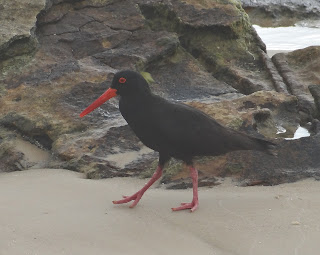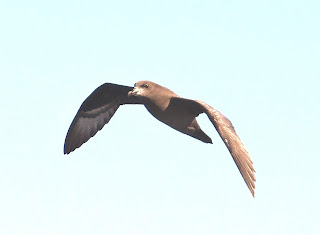Ground Parrot photos by Graeme Chapman
One of the last remaining populations of the endangered
Ground Parrot on mainland Australia appears to be heading inexorably towards
extinction as a result of habitat mismanagement and plans for an airport runway
extension on Queensland’s Sunshine Coast.
A once healthy population of Ground Parrot on the
Sunshine Coast – with as many as 300 birds - has shrunk to fewer than 40 parrots
in four scattered areas of wallum heath extending from Marcus Beach in the
north to Marcoola in the south. A look at what has happened to this population
in recent years and plans for the future - in particular the proposed runway
extension at Sunshine Coast Airport - suggest that its survival is doubtful.
One of Australia’s truly unique birds, the Ground Parrot
is one of just three nocturnal, primarily terrestrial parrots in the world –
the others being the Night Parrot of Australia and the Kakapo of New Zealand.
The Ground Parrot occurs in Tasmania and in a handful of scattered sites on
mainland Australia. The only other population is Queensland is north of the
Sunshine Coast in the Great Sandy World Heritage Area, primarily in the Teewah
Creek catchment at Cooloola.

On the Sunshine
Coast as recently as a decade ago, several Grounds Parrots were in
residence in an area of wallum heath at Noosaville, north of Ernie Creek Road.
The presence of this endangered bird in the area was a key factor in planning
for an extension of Ernie Creek Road across the wallum heath plain of this
sector of Noosa National Park. The road was supposed to be sufficiently
elevated so that parrots would be able to move freely between areas of heath to
its north and south. If they were to fly over (instead of under) the road, roadside
barriers were supposedly high enough to avoid collisions with motor vehicles.
It didn’t work. The Ground Parrots appear to be no longer in this
area as I have failed to hear birds calling during two surveys. The presence of the birds is detected by their distinctive calls at dusk; this is the main method of surveying them.Presumably, the road has been a key source of the demise of Ground Parrots at Noosaville.
Another may be the proliferation of woody shrubs in the
wallum heath plain here. Ground Parrots prefer open, drier heath which
has been burned at intervals of about 8-12 years; regular, controlled burning
appears to be essential to its survival. If heath is not burned, it is
eventually choked with woody shrubs, which are not suitable habitat for the
Ground Parrot. One study suggests that birds vacate heath within 15 years of
its invasion by woody shrubs.
This appears to be what has happened not only at
Noosaville but further south, in the Marcus Beach-Peregian Beach area, again in
Noosa National Park. This is now the most northerly site of the four Ground
Parrot populations surviving on the Sunshine Coast south of Noosa. Here, a
decade ago, about 10 Ground Parrots were heard regularly during surveys in the
area. I have listened for the parrots at
three sites at dusk in recent times in the Marcus Beach-Peregian Beach area on
four occasions, and have heard Ground Parrots twice, with a maximum of two
birds calling. I suspect that just a couple of birds, perhaps three or four,
are hanging on at this site.
Prime Ground Parrot habitat - wallum heath in the Great Sandy World Heritage Area
Again, the wallum heath in this sector of the national
park is choked with woody shrubs. It does not appear to have been been burned
for many years so is no longer suitable habitat for Ground Parrots. The dilemma
for authorities, in terms of fire control, is that the heath is surrounded by
densely populated areas in what is, after all, Australia’s tenth largest city,
and one of the country’s major tourist destinations.
The second Ground Parrot population on the Sunshine
Coast is further south in the Mt Emu section of Noosa National Park. Numbers
are not known but birds have been recorded on both sides of Sunshine Motorway in
very small numbers. Several years ago, Ground Parrots were seen flushing from
the heath ahead of a fire in this area. There are perhaps 5-10 birds in this
area.
The third population is in Mt Coolum National Park, and
the fourth is centred around the nearby Sunshine Coast Airport at Marcoola.
Both these sites are monitored by Environment Department surveys, with between
one and six birds being heard at a total of eight listening stations,
indicating a total likely population of 20-25 birds at the two sites.
I have heard three birds calling simultaneously from
inside the southern boundary of Sunshine Coast Airport. It appears probable
that the area of heath within the airport fencing is the single most important
site for Ground Parrots on the Sunshine Coast.
Data on Ground Parrots on the Sunshine Coast was pulled
together for the Preliminary Review of Significant Factors by environmental
consultancy Ecosmart Ecology; this was part of the Sunshine Coast Airport
Master Plan Project. More than 10 Ground Parrots were heard calling in and
around the airport during surveys, with possibly more present in the area;
Environment Department experts believe the airport population is likely to be
the most stable and important on the Sunshine Coast.
The consultants say it is likely that the airport
population is acting as a source for maintaining dwindling numbers at sites
further north. Interestingly, management practices in the airport have
succeeded in keeping woody shrubs out. Regular slashing and maintenance of
heath within the airport appears likely to simulate the effects of fire,
preventing woody species taking over the smaller seed and fruit producing
plants favoured by the parrots.
The big problem for the Ground Parrot is a $250 million
plan to extend the east-west runway at Sunshine Coast Airport. This project has
been declared a state significant project and fits in nicely with recently
announced plans by Liberal National Party heavyweight Clive Palmer for major
new tourist development projects in the region. (Palmer has ludicrously insisted
that rare birds such as the Ground Parrot can simply fly away and settle
elsewhere.)
Ground Parrot habitat - wallum heath around the north-south runway at Sunshine Coast Airport
According to the airport environmental consultants, the
new runway will dissect Ground Parrot habitats in the north and south of the
airport area. Apart from the shrinkage of already small areas of habitat, the
birds’ ability to fly between those areas could be reduced by increased noise,
light and aircraft traffic. The Sunshine Coast Airport Master Plan Project's Initial Advice Statement concedes that in relation to the Ground Parrot, the runway plan will "directly impact the availability of habitat or food source".
In short, the runway extension could spell the end
of the most important surviving population of Ground Parrot on the Sunshine
Coast, and may lead to the extinction of the Sunshine Coast population of this
endangered species.
One of the aims of federal environmental legislation is
to ensure the survival of endangered species such as the Ground Parrot. The
fate of the bird on the Sunshine Coast is a sad reflection of the failure of
this legislation to meet its objectives.
There's been some local media interest in the issue. This image by Warren Lynam from the Sunshine Coast Daily.




















































